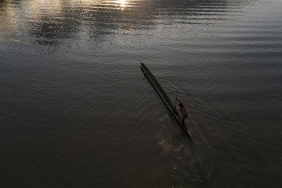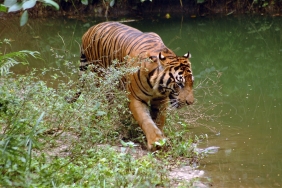CREATIVITY TO SUPPORT CONSERVATION
By: Adrian Pramana (Volunteer Bumi Panda) & Natalia T. Agnika
There are many ways to support conservation efforts, from living a green lifestyle to donating to conservation programs. However, there are also creative ways to support nature conservation. One of them is a creative way done by a young man named Nathan Rusli.
This snake lover wrote the book "Getting to Know Jabodetabek Snakes". In a discussion themed "Getting to Know Snakes and Creative Youth" which took place at Bumi Panda WWF-Indonesia on Sunday (18/09), Nathan shared his love for snakes to his story of establishing the Ciliwung Reptile Center, a community that focuses on educating the public about reptiles and amphibians located in Bogor.
Since the age of 4, Nathan has had a love for reptiles. He used to keep snakes. But later he learned that his way of being a snake lover by keeping them was the wrong way. Eventually, Nathan moved on and was motivated to further educate the public. Moreover, usually people will be afraid when they meet a snake and then kill it because it is considered dangerous. That perception is what he wants to change. People can be more familiar with snakes so that they will be wiser in their actions when handling them. Hopefully, the sustainability of the ecosystem will be well maintained. In his book on Snakes of Jabodetabek, Nathan focuses on mapping the snakes found in the Jabodetabek area.
The discussion participants listened carefully to Nathan's explanation. A question came from a student of Padjajaran University, Bandung named Willy. "What about collectors of reptiles and other wild animals?" he asked. Nathan answered the question wisely. "Love for animals does not mean we can keep them. But love for animals is more about protecting them," Nathan replied.
In addition to presenting Nathan as a resource person, Riza Marlon, a wildlife photographer, also attended the discussion. The man who is usually called Om Caca explained his experience in wildlife photography for about 30 years. Having pursued photography since he was in high school, Riza can be called a specialist in Indonesian wildlife photography. In addition to his outstanding photography work, Riza also wrote a book entitled "107+ Indonesian Snakes" which provides an explanation of snake facts and how to deal with venomous snakes.
In accordance with the theme of the discussion, Riza introduced more snake photography and facts about snakes. Why? Because there is a perception that every snake is venomous and deadly. This one animal is indeed quite frightening to the general public. Of the thousands of snake species in the world, less than half are venomous. In addition to presenting facts about snakes, Riza also motivated the discussion participants to be more creative and also make works that are useful for conservation. Of course, these works must be adjusted to the passion owned. Riza was encouraged to work with his book on snakes in Indonesia because of the lack of literacy about snakes. He hopes that his book can be a reference or guide for the public.
The discussion was warm. Participants who were mostly students from the Bandung area and the general public asked many questions about making creative works, especially how to make a good and correct book. "Making something scientific and knowledgeable can not only be done by scientific circles or scientists, but can also come from a love of something like photography. From there we can learn what the subject of the photo taken is like and what its nature is," concluded Riza while closing the last question in the discussion.





